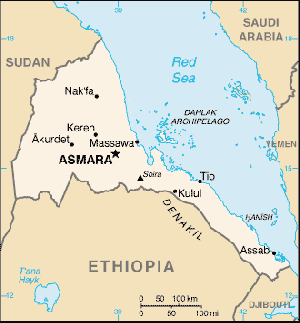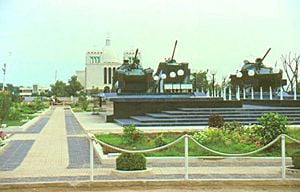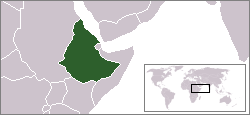Eritrean War of Independence
| Eritrean War of Independence | |||||||
|---|---|---|---|---|---|---|---|
| Part of Conflicts in Africa | |||||||
 Map of Eritrea | |||||||
| |||||||
| Combatants | |||||||
| File:ELF.png ELF EPLF (fought) |
Logistical support: | ||||||
| Commanders | |||||||
| Isaias Afewerki | Haile Selassie (Monarchy era) Mengistu Haile Mariam (Communist era) | ||||||
| Casualties | |||||||
| ~60,000 soldiers[8] ~90,000 civilians[8] |
Ethiopians: 75,000[9]-500,000[10] soldiers Cubans: 5,000[11] | ||||||
Template:Campaignbox Eritrean War of Independence
Template:Campaignbox Horn of Africa The Eritrean War of Independence (01 September, 1961 - 29 May, 1991) was a conflict fought between the Ethiopian government and Eritrean separatists, both before and during the Ethiopian Civil War.
The war went on for 30 years until 1991 when the Eritrean People's Liberation Front (EPLF), having defeated the Ethiopian forces in Eritrea, took control of the country. In April 1993, in a referendum supported by Ethiopia, the Eritrean people voted almost unanimously in favour of independence. Formal international recognition of an independent and sovereign Eritrea followed later the same year.
The two main rebel groups fought two Eritrean civil wars during the war of liberation.
Revolution
During the 1960s, the Eritrean independence struggle was led by the Eritrean Liberation Front (ELF). At first, this group factionalized the liberation movement along ethnic and geographic lines. The initial four zonal commands of the ELF were all lowland areas and primarily Muslim. Few Christians joined the organization in the beginning, fearing Muslim domination.[12] After growing disenfranchisement with Ethiopian occupation, highland Christians began joining the ELF. Typically these Christians were part of the upper class or university-educated. This growing influx of Christian volunteers prompted the opening of the fifth (highland Christian) command. Internal struggles within the ELF command coupled with sectarian violence among the various zonal groups splintered the organization.
The war started on 1 September 1961 when Hamid Idris Awate and his companions fired the first shots against the occupying Ethiopian Army and police. In 1962 the Emperor Haile Selassie of Ethiopia unilaterally dissolved the Eritrean parliament and annexed the country.
Struggle
In 1970 members of the group had a falling out, and several different groups broke away from the ELF. During this time, the ELF and the groups that would later join together to form the Eritrean People's Liberation Front (EPLF) would fight a bitter civil war. The two organizations were forced by popular will to reconcile in 1974 and participated in joint operations against Ethiopia.
In 1974, Emperor Haile Selassie was ousted in a coup. The new Ethiopian government, called the Derg, was a Marxist military junta led by strongman Mengistu Haile Mariam. With this change of government, Ethiopia came under the influence of the Soviet Union.
Many of the groups that splintered from the ELF joined together in 1977 and formed the EPLF. By the late 1970s, the EPLF had become the dominant armed Eritrean group fighting against the Ethiopian government. The leader of the umbrella organization was Secretary-General of the EPLF Ramadan Mohammed Nur, while the Assistant Secretary-General was Isaias Afewerki.[13] Much of the equipment used to combat Ethiopia was captured from the Ethiopian Army.
During this time, the Derg could not control the population by force alone. To supplement its garrisons, forces were sent on missions to instill fear in the population. An illustrative example of this policy was the village of Basik Dera in northern Eritrea. On 17 November 1970, the entire village was rounded up into the local mosque and the mosque's doors were locked. The building was then razed and the survivors were shot. Similar massacres took place in primarily Muslim parts of Eritrea, including the villages of She'eb, Hirgigo, Elabared, and the town of Om Hajer; massacres also took place in predominately Christian areas as well.[12]

By 1977, the EPLF was poised to drive the Ethiopians out of Eritrea, by utilizing a predetermined, simultaneous invasion from the east by Somalia to siphon off Ethiopian military resources. But in a dramatic turnaround, the Derg managed to repulse the Somalian incursion, thanks mainly to a massive airlift of Soviet arms. After that, using the considerable manpower and military hardware available from the Somali campaign, the Ethiopian Army regained the initiative and forced the EPLF to retreat to the bush. This was most notable in the Battle of Barentu and the Battle of Massawa. Between 1978 and 1986, the Derg launched eight major offensives against the independence movements, and all failed to crush the guerrilla movement. In 1988, with the Battle of Afabet, the EPLF captured Afabet and its surroundings, then headquarters of the Ethiopian Army in northeastern Eritrea, prompting the Ethiopian Army to withdraw from its garrisons in Eritrea's western lowlands. EPLF fighters then moved into position around Keren, Eritrea's second-largest city. Meanwhile, other dissident movements were making headway throughout Ethiopia.
Throughout the conflict Ethiopia used "anti-personnel gas"[14]. Napalm was also used,[15] as well as other incendiary devices.
At the end of the 1980s, the Soviet Union informed Mengistu that it would not be renewing its defense and cooperation agreement. With the cessation of Soviet support and supplies, the Ethiopian Army's morale plummeted, and the EPLF, along with other Ethiopian rebel forces, began to advance on Ethiopian positions.
Recognition
After the end of the Cold War, symbolised by the fall of the Berlin Wall, the United States played a facilitative role in the peace talks in Washington during the months leading up to the May 1991 fall of the Mengistu regime. In mid-May, Mengistu resigned as head of the Ethiopian government and went into exile in Zimbabwe, leaving a caretaker government in Addis Ababa. Having defeated the Ethiopian forces in Eritrea, EPLF troops took control of their homeland. Later that month, the United States chaired talks in London to formalize the end of the war. These talks were attended by the four major combatant groups, including the EPLF.
A high-level U.S. delegation also was present in Addis Ababa for the July 1-5, 1991 conference that established a transitional government in Ethiopia. The EPLF attended as an observer and held talks with the new transitional government regarding Eritrea's relationship to Ethiopia. The outcome of those talks was an agreement in which the Ethiopians recognized the right of the Eritreans to hold a referendum on independence. The referendum helped in April 1993 when the Eritrean people voted almost unanimously in favour of independence and this was verified by the UN observer mission UNOVER. On May 28, 1993, the United Nations formally admitted Eritrea to its membership.[16]
| Region | Do you approve Eritrea to become an independent sovereign state? | Total | ||
|---|---|---|---|---|
| Yes | No | uncounted | ||
| Asmara | 128,443 | 144 | 33 | 128,620 |
| Barka | 4,425 | 47 | 0 | 4,472 |
| Denkalia | 25,907 | 91 | 29 | 26,027 |
| Gash-Setit | 73,236 | 270 | 0 | 73,506 |
| Hamasien | 76,654 | 59 | 3 | 76,716 |
| Akkele Guzay | 92,465 | 147 | 22 | 92,634 |
| Sahel | 51,015 | 141 | 31 | 51,187 |
| Semhar | 33,596 | 113 | 41 | 33,750 |
| Seraye | 124,725 | 72 | 12 | 124,809 |
| Senhit | 78,513 | 26 | 1 | 78,540 |
| Freedom fighters | 77,512 | 21 | 46 | 77,579 |
| Sudan | 153,706 | 352 | 0 | 154,058 |
| Ethiopia | 57,466 | 204 | 36 | 57,706 |
| Other | 82,597 | 135 | 74 | 82,806 |
| % | 99.79 | 0.17 | 0.03 | |
ReferencesISBN links support NWE through referral fees
- ↑ 1.0 1.1 Connell, Dan (March 2005). Building a New Nation: Collected Articles on the Eritrean Revolution (1983-2002). Red Sea Press. ISBN 1569021996.
- ↑ Eritrean War of Independence 1961-1993. Retrieved 2007-09-06.
- ↑ A Little Help from Some Friends. Retrieved 2007-09-06.
- ↑ F-15 Fight: Who Won What. Retrieved 2007-09-06.
- ↑ Communism, African-Style. Retrieved 2007-09-06.
- ↑ Ethiopia Red Star Over the Horn of Africa. Retrieved 2007-09-06.
- ↑ Ethiopia a Forgotten War Rages On. Retrieved 2007-09-06.
- ↑ 8.0 8.1 Cousin, Tracey L.. Eritrean and Ethiopian Civil War. ICE Case Studies. Retrieved 2007-09-03.
- ↑ Eritrean War of Independence 1961-1993. Retrieved 2007-09-03.
- ↑ Pool, David (July 1993). Eritrean Independence: The Legacy of the Derg and the Politics of Reconstruction. African Affairs 92 (368): 389-402.
- ↑ Eritrean War of Independence 1961-1993. Retrieved 2007-09-03.
- ↑ 12.0 12.1 Killion, Tom (1998). Historical Dictionary of Eritrea. ISBN 0-8108-3437-5.
- ↑ Discourses on Liberation and Democracy - Eritrean Self-Views. Retrieved 2006-08-25.
- ↑ Johnson, Michael and Johnson, Trish (April 1981). Eritrea: The National Question and the Logic of Protracted Struggle. African Affairs 80 (319): 181-195.
- ↑ Keller, Edmond J. (December 1992). Drought, War, and the Politics of Famine in Ethiopia and Eritrea. Modern African Studies 30 (4): 609-624.
- ↑ Eritrea. Retrieved 2006-08-25.
- ↑ Eritrea: Birth of a Nation. Retrieved 2007-01-30.
See also
- Eritrean Civil War
- List of massacres committed during the Eritrean War of Independence
Further reading
- Country profile: Eritrea BBC 4 November 2005
- Ethiopia Eritrea Independence War 1961-1993
- Eritrean War for Independence
es:Guerra de la Independencia Eritrea he:מלחמת העצמאות של אריתריאה nl:Eritrese Onafhankelijkheidsoorlog
Credits
New World Encyclopedia writers and editors rewrote and completed the Wikipedia article in accordance with New World Encyclopedia standards. This article abides by terms of the Creative Commons CC-by-sa 3.0 License (CC-by-sa), which may be used and disseminated with proper attribution. Credit is due under the terms of this license that can reference both the New World Encyclopedia contributors and the selfless volunteer contributors of the Wikimedia Foundation. To cite this article click here for a list of acceptable citing formats.The history of earlier contributions by wikipedians is accessible to researchers here:
The history of this article since it was imported to New World Encyclopedia:
Note: Some restrictions may apply to use of individual images which are separately licensed.
